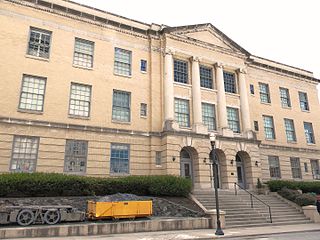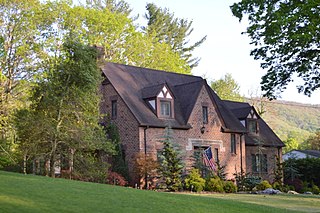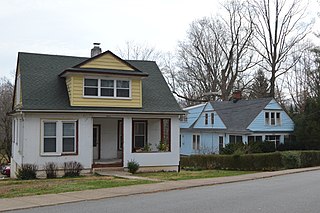
Lovingston is a census-designated place (CDP) in and the county seat of Nelson County, Virginia, United States. The population as of the 2010 Census was 520. Its ZIP Code is 22949. It was among the communities severely affected by flash flooding from Hurricane Camille in 1969.

This is a list of the National Register of Historic Places listings in Detroit, Michigan.

St. Peter's Roman Catholic Church in Harpers Ferry, West Virginia occupies a prominent location on the heights above Harpers Ferry. The original church was built in 1833 in a pseudo-Gothic style which it kept through the Civil War, the only church in Harpers Ferry to escape destruction during the war. The church was extensively altered in 1896 in the then-popular Neo-Gothic style to produce the church seen today. The church commands a sweeping vista across the gorge of the Shenandoah River above its confluence with the Potomac River. The street along the side of the church building is part of the Appalachian Trail. A short trail leads from the church to Jefferson Rock. St. Peter's Church is a mission church of St. James in Charles Town. A Mass is offered at the historic church Sunday at 11 a.m.

Union Hill is a historic district of Richmond, Virginia. According to the Richmond Times Dispatch, the neighborhood "generally is bordered on the south by East Marshall Street and Jefferson Avenue, on the west by Mosby Street, on the north by O and Carrington streets, and angled on the east by North 25th Street." The neighborhood is on the Virginia Landmarks Register and the National Register of Historic Places, and is also one of sixteen designated "Old and Historic Districts" in Richmond.

West Village is a historic district roughly bounded by Jefferson, Kercheval, Parker, and Seyburn Avenues in Detroit, Michigan. Adjacent to the west is the Islandview neighborhood, and adjacent to the east is Indian Village. The district received its name in the mid 20th century because of its location just west of the more well-known Indian Village Historic District. It was listed on the National Register of Historic Places in 1980.

The Jefferson–Chalmers Historic Business District is a historic district located on East Jefferson Avenue between Eastlawn Street and Alter Road in Detroit, Michigan. The district is the only continuously intact commercial district remaining along East Jefferson Avenue, and was listed on the National Register of Historic Places in 2004.
Jefferson Street Historic District may refer to:

Alexander Blount Mahood was a Bluefield, West Virginia-based architect.

Municipal Building, also known as Old Bluefield Municipal Building, is a historic municipal building located at Bluefield, Mercer County, West Virginia. It was built in 1924, and is a two- to three-story, steel and reinforced concrete Classical Revival-style building. It features a three-story high pedimented central pavilion with four engaged Ionic order columns. In 1977, the city government of Bluefield moved to its new building.

Bluefield Downtown Commercial Historic District is a national historic district located at Bluefield, Mercer County, West Virginia. The district includes 73 contributing buildings in Bluefield's central business district. The buildings are primarily three and four story masonry commercial buildings. Notable buildings include The Shamrock Restaurant (1885), People's Bank (1895), the Art Deco / Moderne style Colonial Theatre and Appalachian Power Company building, Law and Commerce Building, Benevolent Protective Order of Elks Building, First Christian Church (1920), Elizabeth Kee Federal Building and Post Office (1911), Bluefield Sanatorium, and West Virginia Hotel (1923) designed by Alex B. Mahood. Located in the district is the separately listed Municipal Building.

South Bluefield Historic District is a national historic district located at Bluefield, Mercer County, West Virginia. The district includes 84 contributing buildings in a residential area of Bluefield known as South Bluefield. The buildings are primarily large single family residences with broad lawns, landscaped entrances and yards. The properties were mostly developed between 1930 and 1940, and are representative of popular architectural styles including Colonial Revival and Classical Revival. A number of the homes were designed by architect Alex B. Mahood.

Upper Oakhurst Historic District is a national historic district located at Bluefield, Mercer County, West Virginia. The district includes 37 contributing buildings in a residential area adjacent to South Bluefield. The buildings are primarily large single-family residences on large lots. The properties were mostly developed during the 1920s, and are representative of popular architectural styles, including Colonial Revival and Classical Revival. A number of the homes were designed by architect Alex B. Mahood.

Country Club Hill Historic District is a national historic district located at Bluefield, Mercer County, West Virginia. The district includes 51 contributing buildings in a residential area of South Bluefield. The buildings are primarily large single family residences with generous front and rear yards. The properties were mostly developed prior to 1940, and are representative of popular architectural styles including Colonial Revival, Classical Revival, and Bungalow styles. The Bluefield Country Club (1920) and some of the houses were designed by architect Alex B. Mahood.

Monroe Street East Historic District is a national historic district located at Wheeling, Ohio County, West Virginia. The district encompasses six contributing buildings. They are a Greek Revival style church built in 1837, a Roman-Tuscan style dwelling dated to 1852 and known as the Paxton-Reed House, and an eclectic 1881 dwelling. Also in the district is a Richardsonian Romanesque style apartment building and a set of vernacular post-American Civil War townhouses.

Wheeling Historic District, also known as the Wheeling Central Business District, is a national historic district located at Wheeling, Ohio County, West Virginia. The district includes 205 contributing buildings in the central business district of Wheeling. It includes the site of the original location of Fort Henry. The buildings are representative of a number of popular architectural styles from the early-19th century through the present including Greek Revival and Late Victorian. The District was listed on the National Register of Historic Places in 1979.

Avery Street Historic District, is a national historic district located at Parkersburg, Wood County, West Virginia. It is to the east of the Julia-Ann Square Historic District and south of the Parkersburg High School-Washington Avenue Historic District. Primarily residential, it encompasses 109 acres and includes churches, a school, and a small commercial area. Built as Parkersburg's first "suburb" in the late-19th and early-20th century in popular architectural style such as Colonial Revival and Queen Anne, the district exhibits 12 distinctive types of Historic architecture. There are 358 contributing buildings, 59 of which are considered to be pivotal. U.S. Senator Johnson N. Camden (1826-1908) owned most of the land now included in the district. Located in the district are the separately listed Parkersburg Women's Club and the First Presbyterian Church/Calvary Temple Evangelical Church.

Clifton Forge Residential Historic District is a national historic district located at Clifton Forge, Alleghany County, Virginia. The district encompasses 728 contributing buildings and two contributing sites in a predominantly residential section of Clifton Forge. It primarily includes single-family frame vernacular dwellings dating to the turn-of-the 20th century. They are vernacular interpretations of a variety of popular architectural styles including Queen Anne, Colonial Revival, and Bungalow. Notable non-residential buildings include the Clifton Forge High School (1928), First Baptist Church, Main Street Baptist Church (1921), First Christian Church (1906), Presbyterian Church (1907), Methodist Church (1908–1910), Clifton Forge Baptist Church (1912), Clifton Forge Woman's Club (1939), and Clifton Forge Armory (1940–1941). Memorial Park and Crown Hill Cemetery are contributing sites. Located in the district and separately listed is the Jefferson School.

The West Franklin Street Historic District is a national historic district located at Richmond, Virginia. It is located along the northern boundary of the Fan district. The district encompasses 71 contributing buildings built between about 1870 and the 1920. It was originally developed as a primarily residential district with buildings in a variety of popular late-19th and early-20th century architectural styles including Greek Revival, Romanesque, Georgian Revival, Queen Anne, and Italianate. Many of the dwellings have been converted to commercial use. In addition, the district's private houses have been converted into multi-family housing and departmental offices for Virginia Commonwealth University. Notable buildings include Franklin Terrace, the Ritter-Hickock House, First Independent Church, Founder's Hall, the Raleigh Building, The Greyston Apartments, Gresham Court Apartments, and the Beth Ahabah Congregation Hall and Synagogue.

The Fry's Spring Historic District encompasses a residential neighborhood of Charlottesville, Virginia, which was developed between 1890 and 1963. Prior to its development, it was a largely wooded area owned for much of the 19th century by the Fry family. The 150-acre (61 ha) district is centered on the private Fry's Spring Beach Club, whose property includes the eponymous spring, and includes 300 mainly residential buildings with historic character. The architectural styles that predominate in the district are Craftsman and Colonial Revival, although other revival styles such as the Spanish and Tudor Revival are represented by smaller numbers of buildings. There are also four churches in the district. The district extends southward along Jefferson Park Avenue, south of the railroad tracks, and radiates out along Stribling, Todd, Robert, and Raymond Avenues as far as Highland Avenue. Another cluster of streets at the southern end of the district includes Jefferson Park Circle, and portions of Eton Road and Monte Vista Avenue.

The Jefferson Street Historic District is a nationally recognized historic district located in Iowa City, Iowa, United States. It was listed on the National Register of Historic Places in 2004. At the time of its nomination it consisted of 39 resources, which included 36 contributing buildings and three non-contributing buildings. This section of the city started to develop to its present form in the late 19th and early 20th centuries. During this period the neighborhood was transformed from residential to include churches and buildings associated with the University of Iowa and its hospitals. Both professionals and business owners lived here, along with working-class people. Graduate students, especially those associated with the medical professions, resided in apartment buildings here. Four architecturally significant churches, along with their attendant buildings, are located in the district.





















